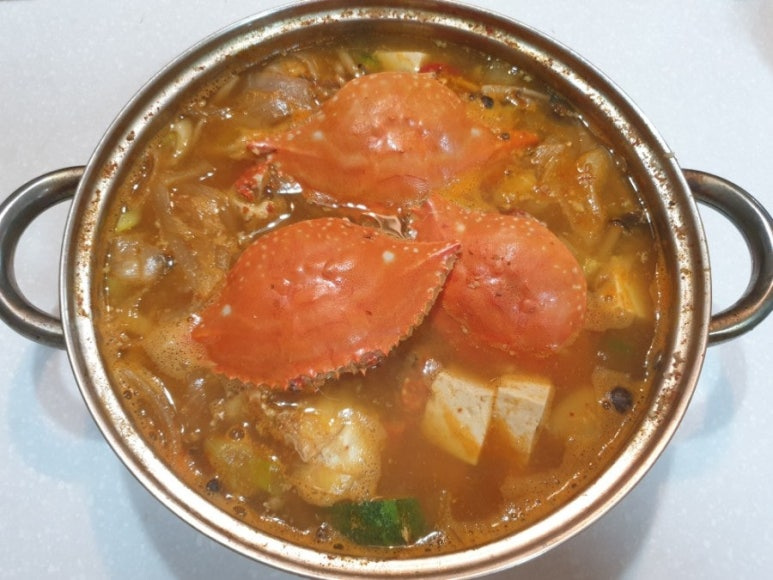Hearty and Refreshing Snow Crab Stew (Kkotgetang)
How to Make Snow Crab Stew with Seasonal Snow Crabs

It’s the peak season for snow crabs! Fall brings wonderful sales at the market, allowing us to enjoy this delicious seafood twice as often. Fresh, seasonal snow crabs are ready to grace your dinner table. My family loves the sweet crab meat, and I adore the rich, savory broth. The anticipation for a bowl of steaming Kkotgetang is already building! This recipe guides you through preparing the crabs and simmering a flavorful stew that’s perfect for a cozy meal.
Kkotgetang Ingredients- 3 fresh live snow crabs
- 1 pack of dashima (kelp) and anchovy broth sachet
- 1/4 Korean zucchini (aebang)
- 1/4 Korean radish (mu)
- 1 handful of your favorite mushrooms (e.g., shiitake, oyster)
- 1/3 onion
- 1/2 block firm tofu
- 1 red chili pepper
- 1 Korean green chili pepper (optional, for extra spice)
- 1 liter of water
Seasoning for Kkotgetang- 2 Tbsp coarse gochugaru (Korean chili flakes)
- 1 Tbsp mirin (or cooking wine)
- 1 Tbsp doenjang (fermented soybean paste)
- 1 Tbsp minced garlic
- 1 Tbsp fish sauce (myeolchi aekjeot)
- Salt to taste
- 2 Tbsp coarse gochugaru (Korean chili flakes)
- 1 Tbsp mirin (or cooking wine)
- 1 Tbsp doenjang (fermented soybean paste)
- 1 Tbsp minced garlic
- 1 Tbsp fish sauce (myeolchi aekjeot)
- Salt to taste
Cooking Instructions
Step 1
The first crucial step is to properly clean the snow crabs. If using live crabs, place them in the freezer for about 30 minutes to make them less active and easier to handle. Once they are less mobile, use a stiff brush to scrub all parts of the crab thoroughly, including the shell, legs, and body. Removing all dirt and grit will ensure a clean-tasting broth.

Step 2
Using kitchen scissors, cut off the crab legs from the body. It’s also helpful to trim the longer legs into 2-3 bite-sized pieces.

Step 3
Next, carefully cut through the joints where the legs connect to the body and where sections of the legs meet. This makes it easier to separate the crab meat later when eating.

Step 4
Snow crabs usually have two large claws. Often, one claw is removed by wiggling it at the joint, as the sweet meat inside is easily sucked out. You can remove one of these claws and discard it, or keep both if you prefer. This step is about making it easier to eat.

Step 5
Locate the crab’s mouth area, near the front of the body. Use your scissors to press down and gently pry apart the carapace (top shell) from the body.

Step 6
Once the carapace is lifted, you’ll see the feathery gills inside. Carefully snip these off with your scissors and discard them. Gills can impart an unpleasant texture and flavor to the broth.

Step 7
Adjacent to the gills, you’ll find a dark-colored ‘stomach sac’ or ‘sand sac’. Remove this as well. It can contain sand or grit, which will make your broth cloudy and less appealing.

Step 8
The edges of the carapace can be quite sharp and pointy. To prevent accidental cuts while handling or eating, trim these sharp points with your scissors.

Step 9
Now, cut the cleaned crab body in half. If you have female crabs with roe, you can leave them whole or cut them in half. Male crabs can be cut in half. Cutting the crabs allows their flavors to infuse more deeply into the broth.

Step 10
In a pot, add 1 liter of water and the dashima and anchovy broth sachet. Bring to a boil over medium heat and let it simmer for about 10 minutes to create a rich, flavorful broth. Remove the sachet.

Step 11
Once the broth is boiling, stir in 1 tablespoon of doenjang (fermented soybean paste) and 1 tablespoon of mirin. The doenjang adds a deep, savory umami, while the mirin helps to eliminate any fishy odor from the crab. Make sure the doenjang dissolves completely.

Step 12
Add the prepared snow crab pieces to the pot. Adding fresh crabs at this stage will result in a clearer and more refreshing broth.

Step 13
When the broth returns to a boil after adding the crab, add the thinly sliced radish, zucchini, onion, and mushrooms. These vegetables will soften and release their sweetness and aroma into the stew.

Step 14
For a nice spicy kick, add 2 tablespoons of gochugaru and 1 tablespoon of minced garlic. It’s generally best to add chili flakes after the ingredients have had a chance to cook slightly to avoid a bitter taste.

Step 15
Add the tofu cut into bite-sized pieces, sliced red chili pepper, and sliced green chili pepper. The green chili adds a pleasant heat, while the red chili adds color. Adjust the amount of chili peppers to your preference.

Step 16
Once everything is simmering vigorously, stir in 1 tablespoon of fish sauce for extra umami. Taste and add salt if needed to adjust the seasoning. Avoid boiling for too long at this stage to keep the broth clear and flavorful.

Step 17
Your delicious Kkotgetang is now ready! Enjoy the warm, invigorating broth and the sweet, succulent crab meat. It’s the perfect dish to pair with a bowl of rice!




